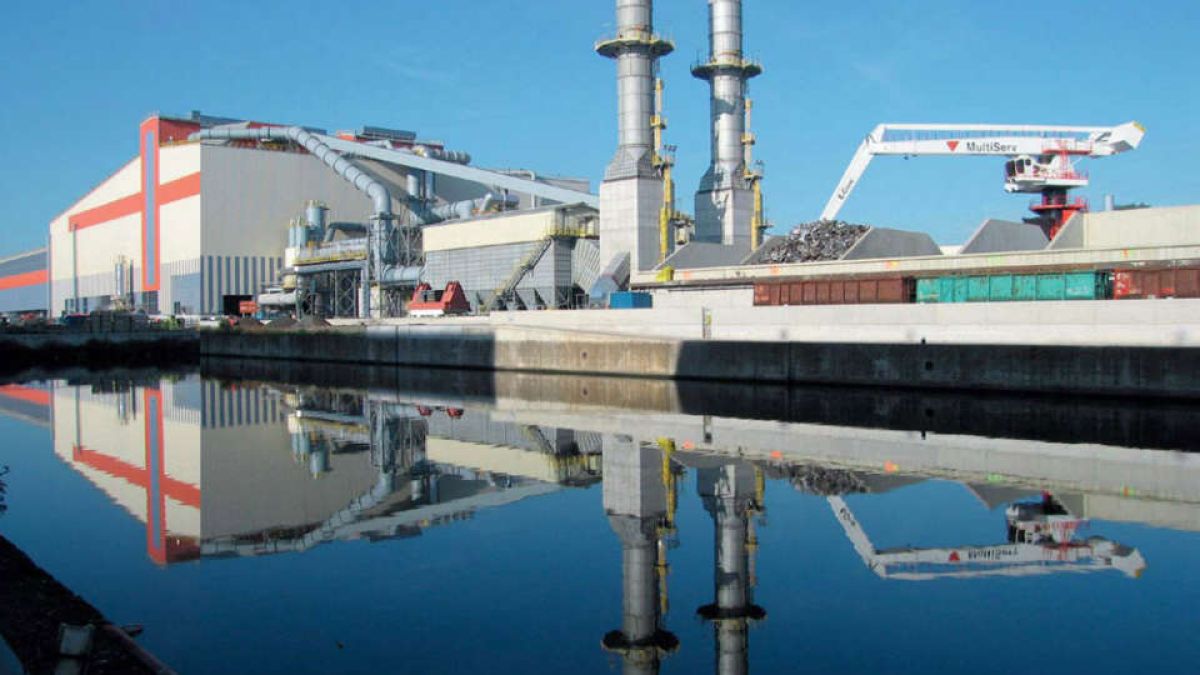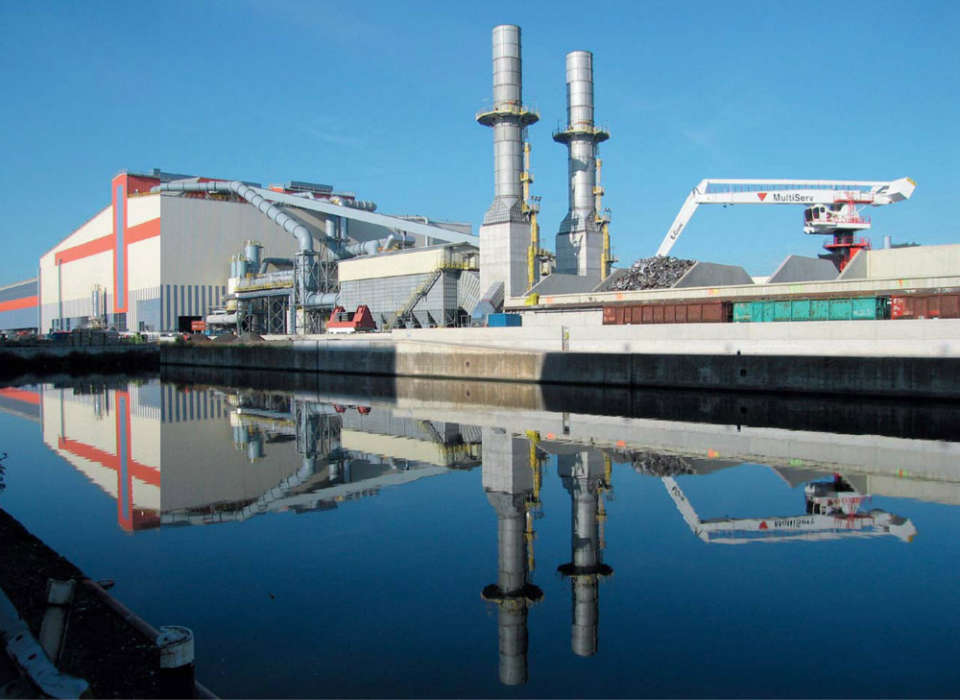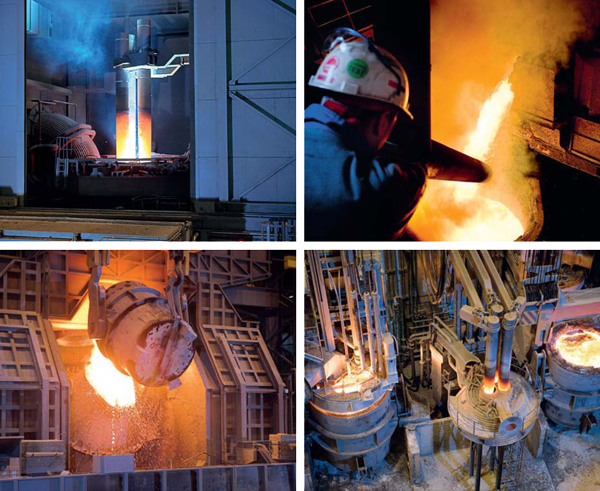
A Brilliant Outlook
For this milestone project, Siemens VAI was responsible for the overall engineering, erection,and commissioning of the steel works. This included the turnkey supply of a 160-ton electric arc furnace, a 180-ton AOD converter, a twin-180-ton-standladle-treatment station with a common furnace, a single-strand slab caster in addition to auxiliary plants and the dedusting and automation systems. The plant was compactly designed with totally optimized logistics and offers the possibility for future expansion.
Electric arc furnace
Raw materials are transported to the site by either rail or water transport. In the scrap yard different scrap qualities are weighed, loaded in baskets, and then transported to the EAF bay. The EAF itself has an eight-meter diameter, and as such is the largest sized furnace employed in stainless steel making. It is complimented by a 160-MVA transformer which is the most powerful in the world used in stainless steel production. A Level 3 planning system provides the setpoints to the automation system. A process model calculates a cost-optimized melting practice for each single scrap blend. The required flux and alloy additions are accurately calculated and automatically charged to the furnace. Adynamic regulation system maximizes the power input and monitors and controls thermal radiation. The economy of operation is further increased through the injection of oxygen and carbon/FeSi through the open slag door by means of a water-cooled lance. This promotes the formation of a foamy slag in the refining phase, which considerably improves the furnace melting efficiency through reduced energy losses. During operations, the EAF is completely enclosed within a dog house to minimize noise and dust emissions. 160 tons of liquid stainless steel are tapped into a transfer ladle every 70 minutes on average. Sampling, temperature measurements, and the remaining slag quantity present in the steel is carried out before charging into the AOD.

Carinox stainless steelmaking plant
AOD converter
Decarburization of the heat is carried out in an AOD converter. With a diameter of 5.8 meters and a heat size of 180 tons, this is currently the largest converter in the world used in the production of stainless steel. Oxygen and nitrogen or argon are blown into the heat by means of nine under-bath tuyeres installed in the side-walls. Outer annular shroud tuyeres and the application of an intelligent wear-monitoring system protect the inner pipes and maximize their lifetime. The use of a top lance accelerates initial decarburization. The Ugine & ALZ-developed TOP AOD process model allows the exact process targets to be met on the basis of input data from the EAF, raw materials, and additives.The average AOD tap-to-tap time is 70 minutes. During longer waiting times, the temperature of the converter can be maintained using a burner and heat-insula-tion hood which covers the converter opening when the converter is tilted into the horizontal position. The ferro-alloy additive-handling and -charging system is comprised of 28 bins and operates fully automatically. It supplies both the EAF and AOD plants.
Twin-stand ladle furnace
The heat is transported by crane from the AOD to one of the twin-ladle furnace stands where stirring, compositional and temperature adjustments of the heat can be carried out. The stands also serve as efficient steel buffers in the case of an unexpected production delay. Alloying materials are charged to the ladle furnacefrom a high-level alloy-bin system and each stand is equipped with a multiline wire-injection facility.
- 160-Ton electric arc furnace
- Ferro-alloy/additive-handling system
- 180-Ton AOD converter
- Twin-station ladle furnace
Dedusting
Primary emissions from the EAF (1.3 million m3/h) and AOD (1.1 million m3/h) plants are cleaned in a bag-filter station equipped with pulse-jet cleaning. All other plant emissions are filtered in secondary dedusting systems. A clean-gas dust content of less than 5 mg/Nm3 conforms to the latest European regulations. Valuable solid residues can be recycled to the steel making process.
Continuous slab-casting machine
The continuous slab-casting machine is designed to cast more than one million tons of slabs per year at thicknesses from 150 to 250 mm and in widths ranging from 1,000 to 1,650 mm. Two tun dish cars, each equipped with a submerged entry-nozzle-changing device, preheating hoods, and a nozzle preheater, support long casting sequences. A top-feeding dummy-barsystem considerably shortens downtime between two sequences. Featuring the latest mold technology, hydraulic oscillators, electromagnetic strand stirring,and Smart Segments, the caster is ideally suited to meet all production and quality requirements. Casting speeds of up to 1.4 meters per minute are possible for ferritic and austenitic steel grades. The automation system includes automatic mold-level control, breakout prediction and dynamic cooling models for improved operational safety. A torch-cutting machine cuts the slab to lengths from 5-12 meters. Slab surfaces are ground by one of the four grinding machines. The close proximity of the Carinox plant to the Carlam hot-strip mill and the use of insulation hoods allow the slabs to be hot-charged to the rolling mill.
Leading supplier
With the completion of this project, the ArcelorMittal group, the largest steel producer in the world today,has acquired a leading position in the stainless steel market. The Ugine & ALZ division in Charleroi, Belgium now supplies approximately 25% of the European market with high-quality stainless steel hot- and cold-rolled products.
Concluding remarks
The large production capacity of the stainless steelworks, coupled with efficient and flexible production scheduling, are key reasons for the economic feasibility of this plant. Advanced process technology, robust and reliable plant equipment, well-trained operational personnel, and the excellent cooperation between the Ugine & ALZ and Siemens VAI project teams were decisive for the overall success of this project.
Source: metals & mining1-2008
Authors: Martin Hiebler, Johann Krumenacker
Contact: convertersteelmaking.metals@siemens.com